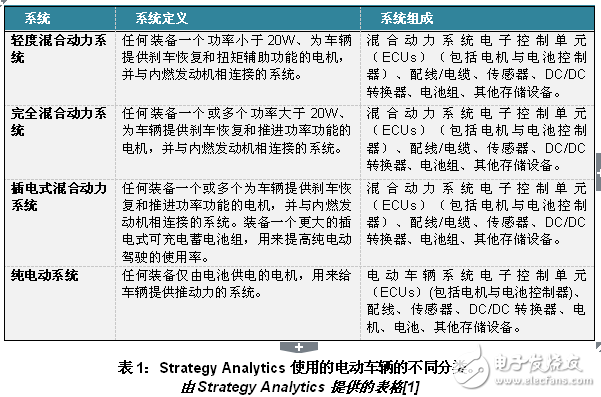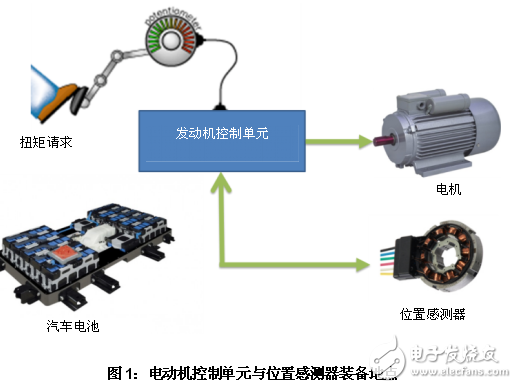Motor drive control integration and equipment intelligence provide space and cost savings for electric and hybrid vehicles.
As the market for hybrid vehicles/electric vehicles (HEV/EV) continues to expand, the need for more efficient and intelligent motor position control becomes even more critical. Today, original equipment manufacturers (OEMs) are more focused than ever on how to enhance the capabilities of the motor (eg torque control) while maintaining a high degree of system visibility through diagnostics to ensure that the health of the system is always known. To achieve these goals, highly integrated solutions for motor position control, especially for motor efficiency and torque control, have become critical.
Foreword
With the increasing demand for more energy efficient transportation methods around the world, HEV/EVs will be the first choice for people to choose. In order to better understand the potential and development of the electric and hybrid vehicle market, we inevitably know what type of vehicle is mentioned in this article. In the report of Strategy AnalyTIcs [1]: “Requirement Forecast for Hybrid Vehicle Systems from 2007 to 2021,†divided HEV/EV into four categories:
Mild hybrid
2. Full hybrid
3. Plug-in hybrid
4. Pure electric
Each of these classifications takes into account the power of the vehicle's motor and the task that the motor is responsible for in the system. For example, in the above report, Strategy AnalyTIcs classifies mild hybrid vehicles as those with motor powers less than 20 kW. This type of motor is used to match the brake recovery and torque assist functions of the internal combustion engine. Once you understand the trade-off between mild hybrid and pure electric, it is easier to understand the overall effective market for motor position sensors in this area. Table 1 lists the system classifications defined in the Strategy AnalyTIc report, which are throughout the text.

Now that we know the type of vehicle we are discussing, we will delve into the market to better understand the potential target market for automakers who are investing in HEV/EV vehicles.
As shown in Table 1, each vehicle may carry 1 to 4 motors. (Equipped with 4 motors is required for each tire). Each motor used will need to be equipped with the right system to drive and control these motors safely and efficiently. These systems require control visibility and granularity to achieve proper torque and motor control. Bearing in mind the knowledge required for the motor and its control system, Table 2 (also from the report of Strategy AnalyTIcs) gives an estimate of the number of vehicles of each type on the market during 2015-2021.

Table 2 shows the steady growth of the HEV/EV market and the automotive market's interest in electric solutions. As demand increases, OEMs will continue to look to improve the performance of these vehicles, while at the same time increasing the use of built-in diagnostics, protection and monitoring equipment to increase the ease of system self-diagnosis.
In order to understand this emerging and fast-growing market, it is crucial to understand the key drivers of car manufacturers in this area. The first is to make it possible for these vehicles to provide precise and precise motor control for their motor drives (inverters). Secondly, why the integration of the system at the device level is critical to providing a smaller, smarter and more efficient solution for HEV/EV.
Precise and precise motor control
For any vehicle, whether electric or not, the motor is the central component of the powertrain that drives the vehicle forward. In particular, electric vehicles require position information of the motor, including angle and speed data, to ensure that the motor control system can work efficiently and accurately. The data collected by the inverter is actively used to control and monitor the current conditions in each motor phase. The process of controlling and regulating the motor current is the process used to create torque for the motor. Torque control of electric vehicles is critical to both customers and car manufacturers. The main areas where torque is critical are:
1. High torque is required to start the motor at low speed and climb the slope
2. Torque control ensures high power when the vehicle is cruising at high speed
3. Fast torque response during acceleration requires precise motor control
4. Precise motor and torque control for high frequencies required for feedback braking
Controlling and understanding the torque in the motor allows the vehicle to provide the driver with smoother power to the wheels. Accurate understanding of the motor position is the key to ensuring proper torque control. By knowing the exact positioning of the motor shaft and carrying an intelligent system that can make decisions based on the motor data, the electric vehicle's control system can accurately calculate the torque the driver needs. The more precise the control, the better the user will experience when dealing with any of the listed conditions.
A simple structure of the motor control system used in electric and hybrid vehicles is shown in Figure 1. Imagine how the system works, you can imagine the scene where you decide to change the speed as the driver drives. When you accelerate (or decelerate) the engine/motor control unit (inverter), the vehicle's battery provides the power to drive the motor. The position sensor (resolver) then reads the angle information of the motor and converts it into a format that the microcontroller of the inverter system can operate. Once the data is transferred to the microcontroller, the motor control system can increase or decrease the motor torque. These increases or decreases in speed are handled in the same way, and the appropriate torque is delivered to the system based on the user's original input.

integrated
With an understanding of the importance of motor control in HEV/EV drive systems, we can now investigate a variety of methods used today to enhance the control of vehicle torque systems.
The central component of the motor control system is an inverter board. This component is used to power the microcontroller, motor drive, and sensor interface used to read and manipulate the collected motor information. In order to be able to do this, the system is equipped with the electronic product under the hood of the vehicle close to the motor. The location of this board presents a challenge for hybrid and electric vehicle manufacturers.
Since the space under the hood of each car is already limited, it is essential to ensure that a solution has a miniaturized structure and package. To achieve smaller solutions, electronic component suppliers are focusing on how to integrate more features and even more devices in a single package board. The automotive devices that are now being introduced to the market integrate some of the components required to implement system functions on a single chip (such as signal chains, communications or power supplies). The integrated chips are then combined to reduce the number of components on the board that are used to control the motor.
By integrating more features and devices into a single package board, hybrid and electric vehicle manufacturers can reduce the overall board size of the inverter system and eliminate the cost of electronic components that are no longer needed. Smaller and more cost-effective electronic component-level solutions give OEMs the advantage of eliminating the need to add cost to their customers.
As the market tends to be integrated, another factor to be addressed is the overall intelligence and connectivity of the system. What does this mean? As the modules inside the vehicle become more complex, system diagnostics and health checks are necessary to ensure they are working properly. For HEV/EV motor control systems, doing these types of checks will make the health of the motor, drive circuit, and position sensor known as variables, and the operation of the system depends on these variables. With the visibility inside the motor system, the evaluation of the drive will be smarter and faster if errors or problems occur. Smarter motor control reports the status of the control system and takes action. Such a motor control system is a necessary condition for the success of the HEV/EV market.
to sum up
Providing smarter, smaller and more cost-effective solutions for automotive system suppliers and automakers is key to the HEV/EV market. As the market expands rapidly, highly integrated solutions for motor control are at the heart of the growth of electric vehicles. Ultimately, providing high-performance systems to customers at a lower price is the real driving force for the market to move toward greater success.
These HEV/EV solutions include the PGA411-Q1 resolver interface and the C2000TM microcontroller. You can find out more about TI HEV/EV solutions on TI's website.
Author: Amanda Weise, Texas Instruments' analog mixed-signal semiconductor products Car Product Marketing Engineer
references
1. Mak, K. (2014). Hybrid Vehicle System Demand Forecast 2007-2021 data document. Strategy Analytics.
2. Singh, B., Jain.P., Mittal.AP, Gupta.JRP (2006). Direct Torque Control: A practical electric vehicle solution. IEEE, TI Virtual Library.
3. Tashakori, A., Ektesabi, M. (2012) Direct torque control drive system for electric vehicles. World Engineering Conference Record Document 2012 Vol II.
Landscape brightening,Landscape lighting,Led landscape lighting
Kindwin Technology (H.K.) Limited , https://www.ktl-led.com